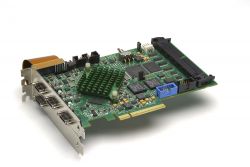Is CoaXPress the Safest Bet in Machine Vision Interfaces?
The CoaXPress® camera standard was developed nearly a decade ago to overcome the limitations of Camera Link™, which at the time was the most popular interface for machine vision systems requiring real time data in small volume systems.
WOBURN, MA, APRIL 4, 2016 -- The CoaXPress® camera standard was developed nearly a decade ago to overcome the limitations of Camera Link™, which at the time was the most popular interface for machine vision systems requiring real time data in small volume systems.
Camera Link began to show its age when CCD and CMOS sensor technology advanced in the mid 2000's, resulting in the need for larger bandwidth to manage the new camera's higher resolution and faster frame rates. Camera Link's limited bandwidth and requirement for short, bulky cables set the stage for the faster, more flexible CoaXPress standard. Despite this, designers still considered it too early to build a system around CoaXPress, even after it won the coveted Vision Award presented in 2009 at the Stuttgart Vision Trade Show.
Fast-forward to today: CoaXPress is now recognized as the most reliable of all machine vision interface standards, especially among those integrators in North America designing for highly-demanding semiconductor and life science applications. Much of the momentum behind CoaXPress is based on its blazingly fast speeds, and its ability to deliver both power and camera control over a single coaxial cable. It has emerged as the top contender to be the interface standard of choice for high-performance, high-speed, long distance image system applications. And due to the use of standard coaxial cable and its huge bandwidth, CoaXPress has found itself not only suited for machine vision applications but also for applications in the medical and defense markets where use of coaxial cable is prevalent.
The Future-proof Solution
Before an image system designer upgrades to a new interface, they want insights into the capabilities of its second or even third generations. This long-range perspective helps companies avoid the cost of a complete system redesign when, for example, data rates need to be doubled and the existing system falls short.
"Many of our CoaXPress customers today are at bandwidth of 6.25 Gbps per coaxial cable and achieving data rates as high as 12 Megapixels at almost 200 frames-per-second," said Donal Waide, Director of Sales and Marketing for BitFlow, Inc., a manufacturer of CoaXPress frame grabbers. "Within the next five years typical data rates are projected to double for many vision applications. This will require the next generation of CoaXPress to offer 12.5 Gbps per cable to support it. Thankfully, that next generation is close to being available which will be a major industry advancement."
According to Waide, the system designers he speaks with are making the move from Camera Link to CoaXPress for one of three reasons: One, they are already at the edge of Camera Link's maximum speed of 850 MB/s and need an interface that will take them further; two, they have a complex system and Camera Link's cables are too short or too difficult to manipulate; or three, they are new to machine vision technology and find CoaXPress the most logical path to a system that is truly future proofed.
Compared to Camera Link (widely adopted since 2001), CoaXPress is still in its infancy stage but is already stable and ready for large scale projects. The Japanese Industrial Imaging Association (JIIA) is the host of the CoaXPress high speed digital interface standard for imaging applications, and the Automated Imaging Association (AIA) and the European Machine Vision Association (EMVA), gave their support for CoaXPress to become a world standard under the G3 Agreement.
Notes Waide: "When it comes down to the details of integrating the image acquisition system of camera and framegrabber into the system, the design engineer will have to switch from a Camera Link based way-of-working to the CoaXPress way-of-working. It's like switching from your iPhone to an Android or vice versa. The change is a little difficult at first due to familiarity, but you will adjust quickly. Once you have made the transition you will find that it is much easier to use. This is the simplicity of CoaXPress. It's not only easy to integrate into an architecture, it will also simplify the system design."
For more information, please call 781-932-2900 or visit www.bitflow.com.
Featured Product

BitFlow Introduces 6th Generation Camera Link Frame Grabber: The Axion
BitFlow has offered a Camera Link frame grabbers for almost 15 years. This latest offering, our 6th generation combines the power of CoaXPress with the requirements of Camera Link 2.0. Enabling a single or two camera system to operate at up to 850 MB/S per camera, the Axion-CL family is the best choice for CL frame grabber. Like the Cyton-CXP frame grabber, the Axion-CL leverages features such as the new StreamSync system, a highly optimized DMA engine, and expanded I/O capabilities that provide unprecedented flexibility in routing. There are two options available; Axion 1xE & Axion 2xE.
The Axion 1xE is compatible with one base, medium, full or 80-bit camera offering PoCL, Power over Camera Link, on both connectors. The Axion 2xE is compatible with two base, medium, full or 80-bit cameras offering PoCL on both connectors for both cameras.
The Axion-CL is a culmination of the continuous improvements and updates BitFlow has made to Camera Link frame grabbers.
